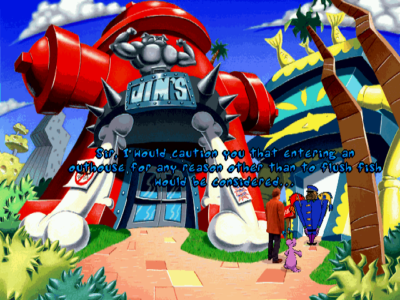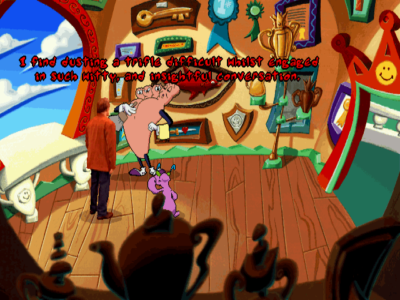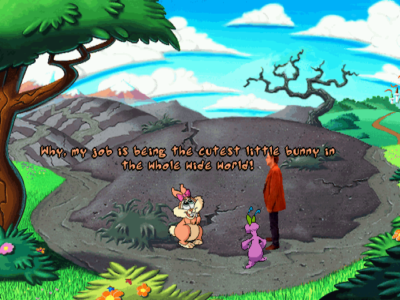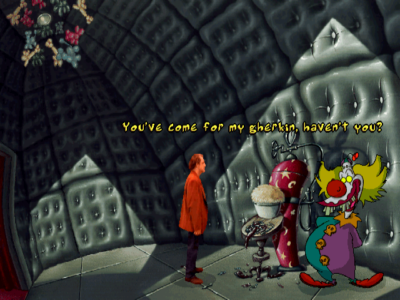
Toonstruck
Written by: Rik
Date posted: April 5, 2016
- Genre: Adventure
- Developed by: Burst Studios
- Published by: VIrgin Interactive
- Year released: 1996
- Our score: 7
This is our second go at reviewing Toonstruck, with the first being sufficiently light on detail to countenance a rare re-write. Last time, we pretty much covered the fact that this was an adventure game starring Christopher Lloyd, and the fact that adventures were fairly thin on the ground at the time.
Taking that as an extremely brief starting point, then, Lloyd is Drew Blanc, a stressed-out cartoonist stuck animating the sickly-sweet adventures of bunny rabbit Fluffy Fluffy Bun Bun for humourless corporate overlord Sam Schmaltz. One night, despairing at being asked to improve the Fluffy Fluffy Bun Bun show by adding ‘more bunnies’, Blanc is somehow sucked into the cartoon world of Fluffy et al. If you’ve seen cartoon/real-life crossovers like Who Framed Roger Rabbit and Cool World (which, true to form, I haven’t) you’ll know the kind of caper we’re dealing with here.
It turns out that Fluffy’s world of Cutopia is under attack from dastardly Count Nefarious, who has developed a machine, the Malevolator, which turns everything from cute to evil. The king of Cutopia, King Hugh (a giant smiley face on legs), offers Drew the chance to return to the real world in exchange for his help. As luck would have it, Hugh’s own chief scientist has developed a counterpart to the Malevolator, the Cutifier, which can help restore things to their cutesy origins. However, a number of components are required to complete construction. Drew must search for these components, armed only with the plans for the Malevolator, which provides clues to the items required.
Drew is not alone in his quest: he’s joined by a sidekick, Flux Wildly, the star of Drew’s less commercially-successful (and possibly hitherto uncommissioned) cartoon show, who hails from Zanydu, the third of the game’s cartoon lands (Cutopia and Nefarious’s homeland, the Malevolands, being the others). Aside from following Drew around and providing various wisecracks, Flux can also be ‘used’ on various items, in the manner of Max from Sam and Max.
Toonstruck really looks great. The artwork is hand-drawn by professional cartoonists, and it really shows. Lloyd is integrated well into the environment, and there’s no jarring difference between the in-game action and the various cut-scenes. The attention to detail is obvious, too – each and every time Lloyd uses an item of inventory, you actually see him using that item, there’s no stock ‘hand moving’ animation here.
The mechanics are of the stripped down, simplified variety that was typical of the time: you can generally only do one thing to one object, although objects can of course be combined. Dialogue options are accessed via symbols, which is a pet hate of mine, but it all seems to work ok. It’s all fairly standard stuff, and there’s nothing here that’ll surprise anyone who’s played an adventure game before.
One thing I thought at the time, and I’d stick to it now, is that Toonstruck isn’t quite as funny as you’d want it to be, particularly considering the talent involved. There’s an occasional snigger to be had here and there, particularly when drawing upon established cartoon staples, such as a group of alligators being blown up and turned into handbags and a pair of boots, or a character attempting to shield himself from a falling heavy object with a comically tiny umbrella. Tim Curry is, as ever, good value as Count Nefarious, while Fluffy Fluffy Bun Bun is as nauseating as you’d expect.
Flux Wildly, however, is a bit of a non-entity as a character. You wouldn’t be able to tell he’s voiced by Dan Castalleneta, if you didn’t know already, and I guess it’s a testament to him (as a professional voice actor) that he doesn’t sound anything like Homer Simpson, but he’s not otherwise memorable, and his back-and-forth with Drew is rather laboured. As Drew, Christopher Lloyd seems fairly bored by the whole enterprise, although I guess you could argue he’s in character as someone slightly bemused by his predicament. It’s also worth mentioning that Toonstruck has a 15 certificate, and so occasionally veers into ‘adult’ territory, be it a knob joke or two, or, er, a cartoon cow that’s into S&M. Tonally, these bits seem a little forced and out of place, although they wouldn’t be so bad if they at least raised a giggle or two (which for me, they didn’t).

In Zanydu, your attempts to, er, flush fish are thwarted by an over-zealous outhouse security professional.
Revisiting Toonstruck though, I realised that I never gave it credit for what a good adventure it was. There’s a clarity about what you need to achieve, from the main initial task of sourcing the objects for the Cutifier, down to the smaller ones involved in acquiring them. The difficulty is pitched at about the right level throughout, and I quite liked the sequence and observation based puzzles (you might need to reach for a pen and paper at various points). There is a sliding block picture thing, which obviously is dreadful, but if you’re careful (and save your game!) you can avoid it altogether.
The odd moments of tension come when Nefarious’s henchmen show up and start looking for you at certain points, but they only appear when you’re in a location with an obvious hiding place, so I don’t think it really counts as an annoying arcade sequence that’s going to trip you up. There is one of those, in the Cutopia amusement arcade, that I thought was going to be problematic, but it turned out to be much easier once I swapped the trackpad for a mouse. Oh, and I should say that first time around, I had dreadful trouble with a sequence that involve tipping over a pot, and I vented about it here, but it turns out I was just being shit.
Everything seem to have been pretty well thought out, and the game flows very well as a result. Most of the time, you have a level of freedom to tackle a number of puzzles in whatever order you wish, but parts of the game world are still restricted at the beginning to ensure you don’t get too stuck trying to solve too many things at once. When it comes to tackling inventory-based puzzles, Drew and Flux will help you: if you’re along the right lines, one of them will say it’s not quite right, or why it’s not quite right, but if you’re barking up the wrong tree entirely, you’ll get nothing but a cartoon sound effect. There are little things I liked, too, such as the explanation of the adventure game’s endless inventory by actually being given a bottomless bag at the outset.
Sections of the game were also apparently excised and saved for a planned sequel, which never came to fruition, although I don’t think this is really noticeable in the finished product. However, I would say that after a mid-game happening, about which I can’t say too much for fear of spoilers, the second half possibly isn’t as strong as the first.
Previously, I’d offered a half-hearted recommendation on the grounds that Toonstruck was an ok adventure and they’d pretty much stopped making any more (hey, it was 2002). I also had a bit of a rant (later removed, accounting for the old write up’s brevity) about Broken Sword, querying why that was so fondly remembered and spawned a series, while Toonstruck wasn’t and didn’t. I think that, although it was rather crudely expressed at the time, that question is still valid. I’ve since warmed to Broken Sword, but I think Toonstruck is a better game, certainly good enough to warrant a sequel, but probably unfortunate that it didn’t do as well as it might have commercially, at a time when adventure games were already starting to decline in popularity.
Anyway, I hereby upgrade my moderate recommendation to a strong one. Toonstruck deserves to be remembered as more than another adventure from the 90s. It’s a pretty good game that’s worth checking out, particularly now it’s been made available digitally.





 Posts
Posts